Review of 98 single board computers. Part 2
Part 1
Part 2
Part 3
Part 4
DE0-Nano-SoC Development Kit / Atlas-SoC Kit

Company / Project - Terasic; RocketBoards.org
Product page
CPU - Intel (Altera) Cyclone V SE (Cyclone V FPGA + 2x Cortex-A9 @ 952MHz)
Memory - 1GB DDR3 RAM
Price - $ 99
The DE0-Nano-SoC Development Kit looks like a commercial debugging board, but it has open specifications and costs only $ 99, which looks like a reasonable price for a Cyclone V based board. The DE0-Nano-SoC board uses a more low-end version of SE, which roughly equivalent to Xilinx Zynq-7020. This SoC combines FPGA and two Cortex-A9 cores running Angstrom v2014.12 Yocto 1.7 with Linux 4.0. The board has GbE, USB OTG, micro USB ports, and a 4GB microSD slot. There is also an accelerometer, an expansion connector connected to the ARM, and various interfaces connected to the FPGA, including a 40-pin connector compatible with the Arduino shields. There is an identical version of Atlas-SoC, which has software designed more for programmers than for hardware developers. There is a community on RocketBoards.org.
DPT-Board
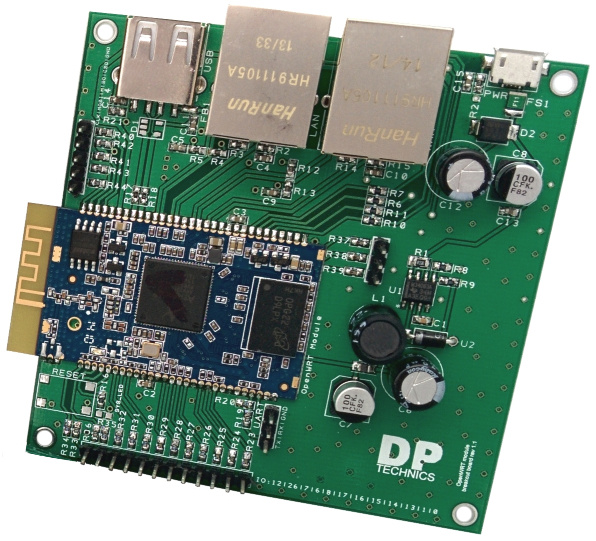
Company / Project - DPTechnics
LinuxGizmos Review
Product page
CPU - Qualcomm Atheros AR9331 (1x MIPS24k @ up to 400MHz)
Memory - 64MB DDR2 RAM
Price - $ 56 (50 Euros) or $ 66 for Plus version
The DPT-Board set consists of two parts and includes separately available DPT-Module COM with Atheros AR9331 chip, running OpenWrt. This energy efficient board for IoT has WiFi, GPIO and JTAG, as well as two 10/100 Ethernet ports and two USB ports. The Plus version has more interfaces, there is also a set for 99 euros, combining a board, a small LCD, a prototype board, a small 9g servos, sensors and other gadgets. All boards come with BlueCherry.io IoT software.
DragonBoard 410c
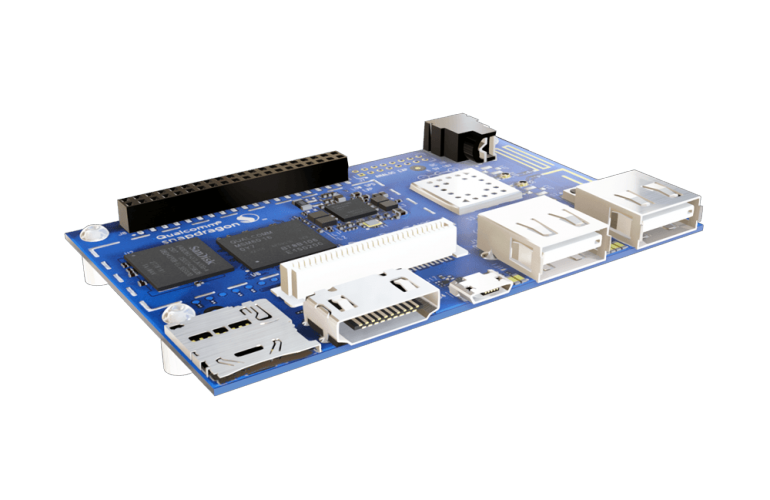
Company / project - Arrow; Qualcomm
LinuxGizmos Review
Product page
CPU - Snapdragon 410 (4x Cortex-A53 @ 1.2GHz); Adreno 306 GPU
Memory - 1GB LPDDR3 RAM; 8GB eMMC
Price - $ 75
The DragonBoard 410c from Arrow and Qualcomm was one of the first “hacker” boards on 64-bit ARM, and was built on the basis of the four-core A53 Snapdragon 410 from Qualcomm. The board has a size of 85 x 54mm, almost the same as the Raspberry Pi. There is no Ethernet port, but there is WiFi, Bluetooth, GPS, HDMI, microSD, 3 USB ports, and 96Boards compatible low-speed 40-pin and 60-pin high-speed connectors. The singleplate supports Android 5.1, Debian 8.0, and Windows 10 IoT Core. In March, Arrow announced the 96Boards CE Chameleon96 single-board running Linux on the Intel Cyclone V ARM / FPGA SoC, which has WiFi, BT, and security features with quantum stability (!). However, the price is still unknown.
Edison kit for arduino

Company / Project - Intel
LinuxGizmos Review
Product page
CPU - Intel Atom “Tangier” (2x x86 @ 500MHz); Quark co-processor
Memory - 1GB LPDDR3 RAM; 4GB eMMC
Price - $ 110
The computer on the Intel Edison module is not a single-board device, but is sold as part of the Edison Kit for Arduino. Intel is currently focused on Intel Joule, but Edison will be available for a while. Intel's Edison Kit for Arduino sells for $ 110 at Sparkfun and Adafruit. The Edison module is 36 x 25mm in size and runs under the Yocto Project. The processor is a 22nm Intel Atom with cropped HD graphics. The full suite has WiFi, BLE, a microSD slot, and two micro USB ports. There is also an Arduino connector and a 70-pin connector. Arduino extensions can also be found in many Edison “hacker” kits available from various vendors, such as SeeedStudio (Grove sensors) and DSF Robot.
Firefly-rk3288

Company / Project - Firefly
Product page
CPU - Rockchip RK3288 (4x Cortex-A17 @ 1.8GHz); Mali-T760 GPU
Memory - 2GB DDR3 RAM expandable to 4GB; 16GB eMMC expandable to 32GB
Price - $ 129
Since the FirePrime S / S + board is no longer sold on the RK3128, the Firefly-RK3288 board is now the junior Firefly single-board. Size 118 x 85mm, dual boot Ubuntu and Android with support for Linux 4.4, at a frequency of 1.8GHz, quad-core A17 RK3288 with a Mali-T760 GPU. The Firefly-RK3288 card has an HDMI 2.0 port that can output 4Kx2K @ 60Hz. The board has dual-band 802.11ac, Bluetooth 4.0, GbE port, three USB ports. The single board is equipped with VGA, LVDS, eDP, MIPI-DSI, MIPI-CSI, S / PDIF, a debugging port, and IR. I / O ports are available on two 42-pin connectors. The board supports doubling the amount of RAM and flash to 4GB and 32GB, but these options are currently not available for ordering. There used to be a version of “Plus” with extended memory for $ 199. “Fireasy” WiFi, touchscreen display, fans, cameras are sold as options.
Firefly-RK3288 Reload
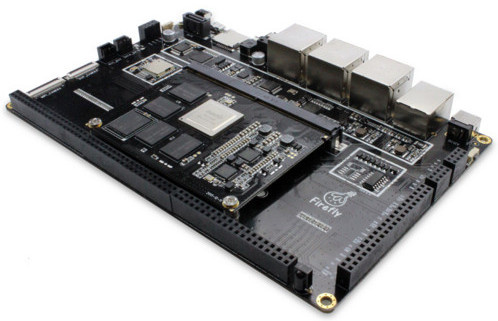
Company / Project - Firefly
LinuxGizmos Review
Product page
CPU - Rockchip RK3288 (4x Cortex-A17 @ 1.8GHz); Mali-T760 GPU
Memory - 2GB DDR3 RAM; 16GB eMMC
Price - $ 159
The Firefly-RK3288 Reload card has the same SoC and supports the same OS as the Firefly-RK3288, but has a constructive COM-module / baseboard. The size of the baseplate is 178 x 117mm, the size of the COM module is 82 x 60mm, they are connected via a 314-pin MXM connector. The Reload board has all the same as the original, and adds a second HDMI output, an HDMI input, and a second DVP interface for a 5MP camera in addition to 13MP-DVP. The Reload card also has a SATA port, a third USB host, and a micro-USB OTG, and a 184-pin expansion card connector.
Firefly-rk3399

Company / Project - Firefly
LinuxGizmos Review
Product page
CPU - Rockchip RK3399 (2x Cortex-A72 @ up to 2.0GHz, 4x Cortex-A53 at up to 1.42GHz); Mali-T860 GPU
Memory - 2GB or 4GB (Plus) DDR3 RAM; 16GB or 32GB eMMC (Plus)
Price - $ 179 or $ 219 (Plus)
The new Firefly-RK3399 board is one of the most powerful "hacker" boards. SoC Rockchip RK3399 has two Cortex-A72 cores and four A53 cores, as well as a high-end Mali-T860 GPU. Over the next two months, a 124 x 93mm single board will be shipped for “stock” for $ 179 with 2GB RAM and 16GB eMMC and for $ 219 with 4GB / 32GB, then the price will be increased by $ 20. There is also a microSD slot and an M.2 slot for SSD. GbE port, dual-band 802.11b / g / n / ac, Bluetooth 4.1 with BLE, and a SIM card slot are standard, and there is a mini-PCIe slot for an optional LTE module. There are also HDMI and DP ports supporting up to 4K @ 60Hz, as well as MIPI-DSI, eDP, DVP, IR, and 2x MIPI-CSI. The Firefly-RK3399 card is equipped with two USB 3.0 ports (including Type-C), two USB 2.0 ports, a 42-pin expansion connector, and various audio interfaces. The board has dual boot Android 6.0.1 and Ubuntu 14.04.
Galileo Gen 2
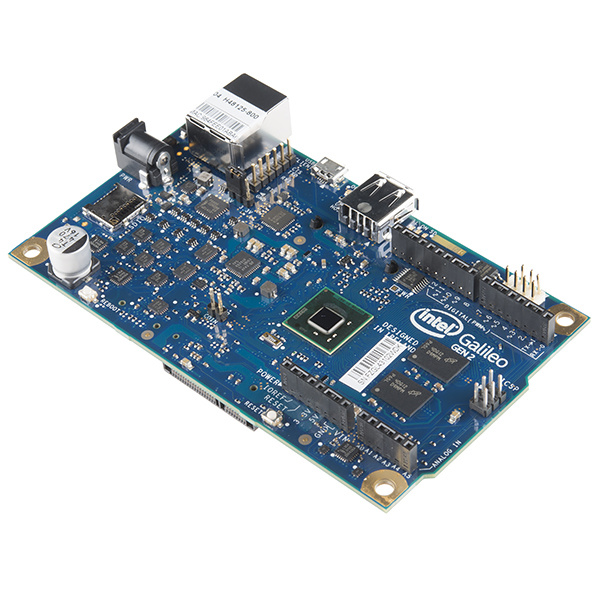
Company / Project - Intel
LinuxGizmos Review
Product page
CPU - Intel Quark X1000 (1x Pentium-compatible @ 400MHz)
Memory - 256MB DRAM
Price - $ 61.69
Intel's Galileo 2 IoT based on the energy-efficient Quark X1000, compatible with the Arduino, has an optional 12V PoE, as well as USB, PWM, and GPIO. Intel is now moving from Quark to non-Linux compatible Quark SE modules in Intel Curie, and the Galileo board will disappear, but this is currently the only choice if you want to run Linux on Quark. The lowest price is now $ 61.69 in Newegg.
Gizmo 2

Company / Project - AMD, GizmoSphere.org, Symmetry Electronics
LinuxGizmos Review
Product page
CPU - AMD G-Series GX210HA SoC (2x x86 @ 1GHz); Radeon hd 800 graphics
Memory - 1GB DDR3 SDRAM
Price - $ 165
Symmetry (Semiconductorstore.com) and GizmoSphere.org have updated their G-Series SoC with Linux support. Gizmo 2 has HDMI, microSD, mSATA, and USB 3.0 port. The board with open Gizmo 2 specifications is in the shadow of cheaper, more powerful x86 boards, the links to the forum no longer work, the project is close to closure. This may be your last chance to see the board on the G-series.
Hikey

Company / Project - LeMaker
LinuxGizmos Review
Product page
CPU - HiSilicon Kirin 6220 (8x Cortex-A53 @ 1.2GHz); Mali 450-MP4 GPU
Memory - 1GB or 2GB LPDDR3 RAM; 8GB eMMC
Price - $ 75 (1GB) or $ 109 (2GB)
The flagship 96Boards-compatible Hikey board is made by LeMaker (Banana Pro), and comes with an 8GB flash memory and 1GB or 2GB memory to choose from. 64-bit processor, 8 cores, board size 85 x 54mm, form factor 96Boards Consumer Edition, has 40-pin low-speed and 60-pin high-speed connectors. Includes WiFi, Bluetooth, HDMI, MIPI-DSI, and three USB ports. Like the other 96Boards, the HiKey comes with Linaro Debian Linux (4.4.11) and Linaro / AOSP Android distributions. Both LeMaker and ArcherMind recently launched a 96Boards CE-compatible Hikey 960 SBC board using the quad -A73, quad -A53 Kirin 960 SoC from HiSilicon, but at $ 239, which exceeds our limit ($ 200).
Hummingboard base

Company / Project - SolidRun
LinuxGizmos Review
Product page
CPU - NXP i.MX6 Solo, DualLite, Dual, or Quad (1x, 2x, 2x, or 4x Cortex-A9 @ up to 1.2GHz); Vivante 2D / 3D GPU
Memory - Solo (512MB), DualLite and Dual (1GB), and Quad (2GB) DDR3 RAM; optional eMMC or NOR flash
Price - $ 74 to $ 130
Like HummingBoard-Pro, the -Base version is sandwich-style, has a size of 86 x 55mm, and, like the HummingBoard-Gate and -Edge versions, has optional WiFi and Bluetooth, and supports a number of MicroSOM modules based on all four versions i.MX6. In October 2016, SolidRun released an updated version of MicroSOM 1.5, available for all HummingBoard models, and can also be bought separately. The rev 1.5 version of the MicroSOMs has FlexCAN and TI WiLink8, as well as optional eMMC and NOR flash up to 8GB. The HummingBoard Base baseboard has ports like the Raspberry Pi, including a 26-pin connector. Both versions, -Base and -Pro, each have two USB 2.0 ports, as well as HDMI, MIPI-CSI, and S / PDIF audio. Like other HummingBoards boards, the GbE port is limited to 470Mbps due to i.MX6 restrictions, there are Debian, Yocto Project, and Android distributions.
Hummingboard-pro

Company / Project - SolidRun
LinuxGizmos Review
Product page
CPU - NXP i.MX6 Solo, DualLite, Dual, or Quad (1x, 2x, 2x, or 4x Cortex-A9 @ up to 1.2GHz); Vivante 2D / 3D GPU
Memory - Solo (512MB), DualLite and Dual (1GB), and Quad (2GB) DDR3 RAM; optional eMMC or NOR flash
Price - from $ 84 to $ 210 (Pro)
The HummingBoard-Pro is identical to the HummingBoard-Base, except that mini-PCIe, mSATA, LVDS, analog audio, RTC, and IR are added. Also added two additional USB ports. Optionally available microSD slot, wireless module, power adapter and housing.
Hummingboard edge
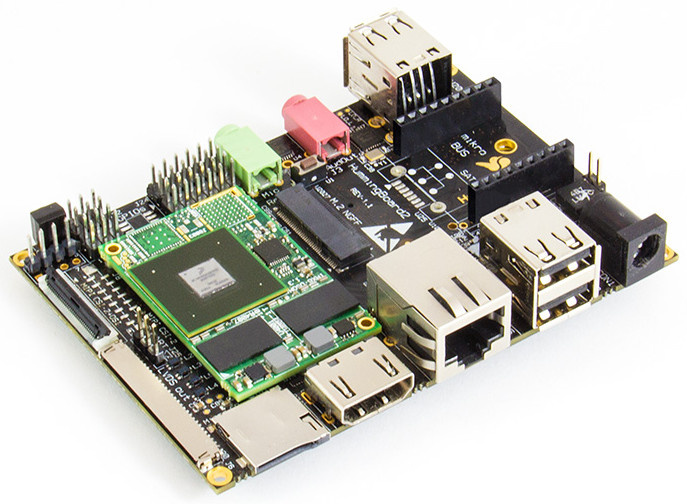
Company / Project - SolidRun
LinuxGizmos Review
Product page
CPU - NXP i.MX6 Solo, DualLite, Dual, or Quad (1x, 2x, 2x, or 4x Cortex-A9 @ up to 1.2GHz); Vivante 2D / 3D GPU
Memory - Solo (512MB), DualLite and Dual (1GB), and Quad (2GB or 4GB) DDR3 RAM; 4GB eMMC plus optional eMMC or NOR flash on MicroSOM
Price - $ 99 to $ 252
The HummingBoard-Edge has a larger size (102 x 69mm) than the HummingBoard-Pro, and the same features. In addition, there were four USB 2.0, M.2, SIM, and MIPI-DSI connectors were added. An enlarged 36-pin GPIO connector is also installed, the supply voltage has a wide range of 7-36V, and an eMMC is added (optional). Like Pro, there are many optional wireless modules, and, for the Quad model (which exceeds the $ 200 threshold in maximum configuration), 4GB of RAM.
Hummingboard gate

Company / Project - SolidRun
LinuxGizmos Review
Product page
CPU - NXP i.MX6 Solo, DualLite, Dual, or Quad (1x, 2x, 2x, or 4x Cortex-A9 @ up to 1.2GHz); Vivante 2D / 3D GPU
Memory - Solo (512MB), DualLite and Dual (1GB), and Quad (2GB or 4GB) DDR3 RAM; optional eMMC or NOR flash
Price - from $ 84 to $ 235
As the name implies, the HummingBoard-Gate is designed primarily as an IoT gateway. It has fewer features than HummingBoard-Edge, no LVDS, analog audio, eMMC and M.2. Otherwise, it is almost identical, has the same size of 102 x 69mm, power 7-36V, mini-PCIe slot, optional wireless modules and a metal case. The main innovation is the MikroBus socket, in which you can install the I / O 200-plus Click extension from MikroElektronika and sensor modules.
Inforce 6410Plus
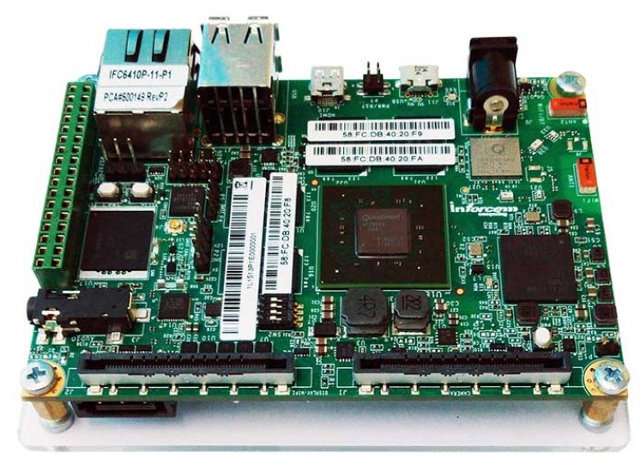
Company / Project - Inforce Computing
LinuxGizmos Review
Product page
CPU - Qualcomm Snapdragon 600 (4x “Krait” cores @ 1.7GHz); Adreno 320 GPU; QDSP6V4 DSP
Memory - 2GB PCDDR3 RAM; 4GB eMMC
Price - $ 143
The Inforce 6410Plus is mainly focused on the commercial market, but is an open platform of interest to home-builders. The Plus model has advanced features focused on robotics and IoT, including GPS, MIPI-CSI, MIPI-DSI, a more powerful 12V power supply, a lower 16mm profile, and a new 34-pin PAC extension connector. The board has a size of 100 x 70mm, a Pico-ITX form factor and works under Ubuntu Linux (kernel 3.4) or Android 4.4. the board has a quad-core Cortex-A15 Snapdragon 600. Instead of LVDS, there are two MIPI-DSI interfaces in addition to micro-HDMI. Also there is GbE, microSD, SATA, WiFi, BT, three USB ports, including the OTG port.
Khadas Vim
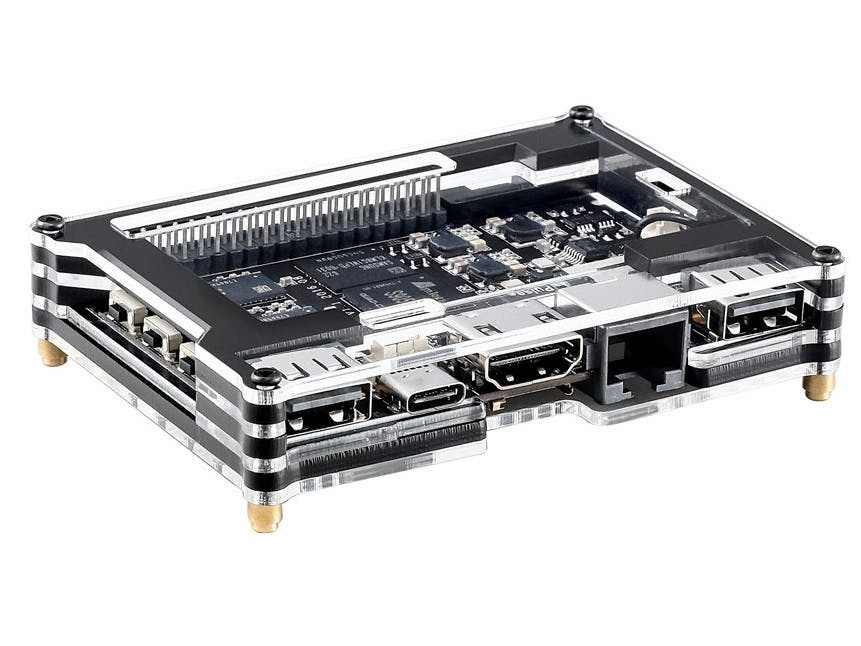
Company / Project - Khadas
LinuxGizmos Review
Product page
CPU - Amlogic S905X (4x Cortex-53 @ up to 2GHz); Mali-450 MP2 GPU
Memory - 2GB DDR3 RAM; 8GB or 16GB (Pro) eMMC
Price - $ 50 or $ 65 (Pro)
Chinese startup Khadas debuted with the media-oriented Khadas Vim board at the end of 2016. The size of the board is 82 x 58mm Amlogic S905X processor for the low-end version of the four-core Cortex-A53 Amlogic S905 on Odroid-C2. Khadas supports Android 6.0 with Kodi-17 software, as well as Ubuntu 16.04, Buildroot, and OpenELEC / LibreELEC version 7.0. Pro version boots with eMMC 5.0 from 8GB to 16GB, and has WiFi from 802.11n to 802.11ac. Both versions have Bluetooth 4.2, Fast Ethernet, three USB 2.0 host ports, one Type C OTG port. There is also HDMI 2.0a, IR, microSD, and a 40-pin expansion connector (but not compatible with RPi). Shipping to the USA is free.
LeMaker Guitar

Company / Project - LeMaker
Product page
CPU - Actions S500 (4x Cortex-A9 @ up to 1.6GHz); PowerVR SGX544 GPU
Memory - 1GB or 2GB DDR3 RAM; 8GB eMMC
Price - $ 59
The sandwich-style LeMakerSBC Guitar motherboard includes a quad-core Actions S500 module. Images for Android 5.0, Ubuntu Mate, Ubuntu Core, Lemuntu, Armbian, ArchLinux, and LeMaker XBMC are available. The size of the baseboard is 88 x 81mm, it contains WiFi, Bluetooth, Ethernet, HDMI, micro USB 3.0, and two USB host ports. There is also a MIPI-CSI interface and a RPi-compatible 40-pin connector.
LinkIt Smart 7688

Company / Project - MediaTek Labs, SeeedStudio
LinuxGizmos Review
Product page
CPU - MediaTek MT7688AN (1x MIPS core @ 580MHz); Atmel ATmega32U4 MPU (Duo only)
Memory - 128MB RAM; 32MB flash
Price - $ 12.90 or $ 15.90 (Duo)
A tiny board from MediaTek Labs and SeeedStudio, LinkIt runs on OpenWrt, like the 580MHz MIPS SoC, and serves as the IoT interface. The $ 13 model is 56 x 26mm in size, equipped with WiFi, microSD, and two micro USB ports, and $ 16, 61 x 26mm LinkIt Smart 7688 Duo has an MPU for Arduino support. The board has GPIO, I2C, SPI, UART, PWM, and Fast Ethernet, plus I2S audio in the base model and ADC with SPI in Duo. SeeedStudio offers an optional LinkIt surcharge, and three options for Duo: a board for Arduino and Grove sensors, and a richer Grove Starter Kit. Available MediaTek Cloud Sandbox service for data collection and analysis.
LinkSprite Acadia V3

Company / Project - LinkSprite Technologies
LinuxGizmos Review
Product page
CPU - NXP i.MX6 Quad (4x Cortex-A9 @ up to 1.2GHz); Vivante GC355 GPU
Memory - 1GB DRAM
Price - $ 119
The LinkSprite Acadia card runs under Ubuntu 12.04 or Android 4.4, has an i.MX6 Quad processor, unlike the Allwinner SoC, which are commonly used in the pcDuino boards from LinkSprite. Compared to the V2 model described above, the V3 has lost its eMMC flash, but has a microSD slot and two SD slots. There is also HDMI, LVDS, SATA, audio, GbE connector, three USB ports, two camera interfaces, and an Arduino-compatible
expansion connector.
LinkSprite Arches

Company / Project - LinkSprite Technologies
LinuxGizmos Review
Product page
CPU - Allwinner A80 (4x Cortex-A15 @ up to 2GHz, 4x Cortex-A7 @ up to 1.3GHz); PowerVR G6230 GPU
Memory - 2GB DRAM; 8GB flash
Price - $ 95
LinkSprite Arches was originally released as pcDuino8 in May 2014, was used by beta testers at the end of the year, and went on sale in 2015. The Arches card runs on Linux or Android, contains the eight-core Allwinner A80, and is similar to Cubieboard4 based on the A80. The board is equipped with microSD, HDMI, GbE, three USB ports (one of them is 3.0 OTG), as well as WiFi, Bluetooth, and CSI interface.
MarsBoard RK3066 Pro

Company / Project - Haoyu Electronics, MarsBoard.com
Product page
CPU - Rockchip RK3066 (2x Cortex-A9 @ 1.6GHz); Mali-400 GPU
Memory - 1GB DDR3 RAM; 4GB eMMC flash
Price - $ 140
The Haoyu MarsBoard RK3066 Pro, sold in Waveshare, has the same SoC RK3066, memory, and modular design, and supports Linux / Android, like the standard MarsBoard RK3066, but an Arduino interface, a VGA port, a microSD slot, and 1- interfaces are added Wire, SPI, I2C, and UART. The Pro also has five USB ports, 10/100 Ethernet, HDMI, LCD, S / PDIF, IR, and camera interfaces. We removed the standard MarsBoard RK3066 model from our list, because it is no longer sold on the official website, and the price has increased to $ 77 on Amazon. We also removed the Marsboard AM335x. There are many richer in features, cheaper, and officially authorized clones of BeagleBone. The Marsboard spam-filled forum may be close to being closed.
MediaTek X20 Development Board
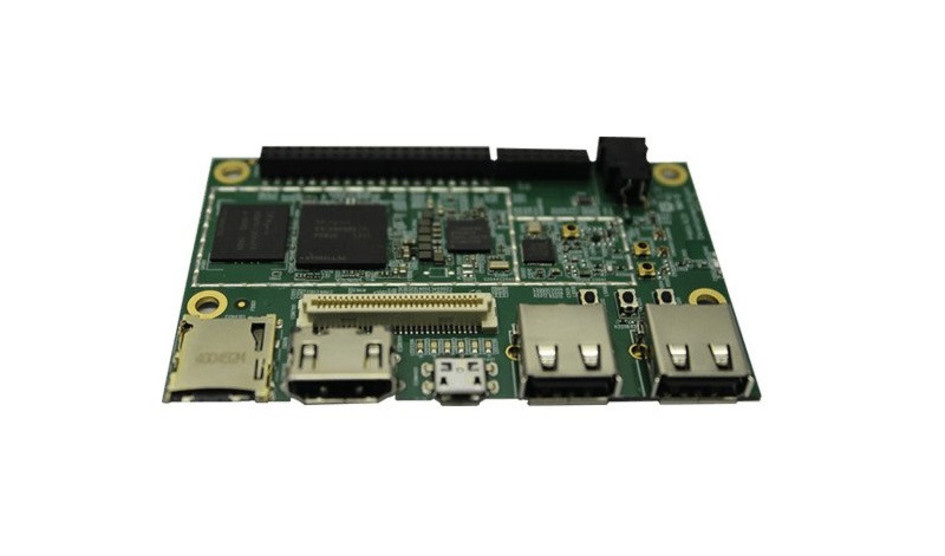
Company / project - ArcherMind (AlphaStar); MediaTek
LinuxGizmos Review
Product page
CPU - MediaTek Helio X20 (4x Cortex-A53 @ 1.4GHz, 4x Cortex-A53 @ 1.95GHz, 2x Cortex-A72 cores @ 2.5GHz); Mali-T880 GPU
Memory - 2GB LPDDR3 RAM; 8GB eMMC
Price - $ 199
The MediaTek X20 Development Board, focused on Android, is not only the most expensive motherboard in the review, which came close to the $ 200 limit, but also the most powerful, comparable only to the similarly priced UP Squared based on Intel Apollo Lake. Available on Seeed and on AliExpress for $ 199, the board complies with the 96Boards CE standard and is based on MediaTek's 10-core SoC (Cortex-A53 and -A72) Helio X20. The Helio X20 processor has two Cortex-A72 cores operating at a frequency of 2.5GHz, and two quad-core, Big.Little banks on Cortex-A53 cores at a frequency of 1.95GHz. There is also a powerful Mali-T880 MP4 GPU interface. The 85 x 54mm board has the usual 40B and 60 pin connectors for 96Boards and a 16 pin analog interface. You also get WiFi, BT, GPS, HDMI, and microSD, as well as two USB 2.0 host and micro USB ports (device-only). The only firmware available at the moment is Android 6.0 BSP.
MinnowBoard Turbot Dual

Company / Project - Intel, ADI, MinnowBoard.org
LinuxGizmos Review
Product page
CPU - Intel Atom E3826 (2x Bay Trail @ 1.46GHz); Intel HD Graphics
Memory - 2GB DDR3L RAM
Price - $ 146
Built by ADI Engineering, with the support of the MinnowBoard.org and Intel community, the MinnowBoard Turbot board with dimensions of 3.9 x 2.9 inches replaced MinnowBoard Max from CircuitCo. The price range is up to $ 160, but can be bought for $ 146 on Netgate. The board includes a low-speed connector for Arduino-like extensions, and a 60-pin high-speed connector for Lures extensions. Other interfaces include two USB, GbE, micro-HDMI, SATA. Supported by Debian, Ubuntu, Yocto Project, Android 4.4, and Windows 10. The Turbot Dual board, recently added with an almost identical MinnowBoard Turbo Quad-core (see below).
MinnowBoard Turbot Quad-core
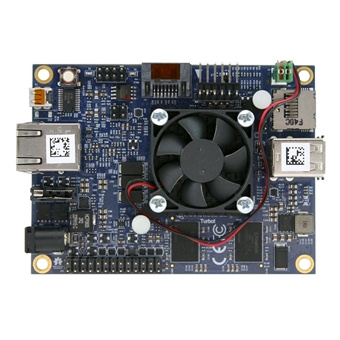
Company / Project - Intel, ADI, MinnowBoard.org
LinuxGizmos Review
Product page
CPU - Intel Atom E3845 (4x Bay Trail @ 1.91GHz); Intel HD Graphics
Memory - 2GB DDR3L RAM
Price - $ 190
The MinnowBoard Turbo Quad-core board went on sale recently, has the same size of 99 x 74mm as the dual-core Turbot Dual, and basically the same features. The Quad has a quad core, 1.91GHz Atom E3845 from the same 22nm Bay Trail generation, and has a heat sink, a fan, and a faster Intel I210 GbE controller. About a year ago, ADI introduced a large (103 x 99mm) MinnowBoard Turbot Dual-E board with a choice between a dual-core Atom E3826 and a quad-core E3845 SoC. The Dual-E card is named so because it has a GbE port, and also has a combined M.2 / micro-SIM slot for WiFi, LTE, or SSD. No pricing information yet.
MYS-6ULX SBC

Company / Project - MYIR
LinuxGizmos Review
Product page
CPU - NXP i.MX6 ULL or i.MX6 UL (1x Cortex-A7 @ 528MHz or 696MHz, respectively); 2D PXP GPU
Memory - 256MB DDR3 RAM; 256MB NAND
Price - $ 24.80 (i.MX6 ULL) or $ 26.80 (UL)
MYIR mainly produces commercial boards, but they also released several “hacker” boards with open specifications, such as MYS-6ULX, which is suitable for home builders. They also have a Rico Board (Sitara) and Z-turn (Zynq) (see below). For prices ranging from $ 25 to $ 27 MYS-6ULX, you are offered a choice between i.MX6 UL (UltraLite) or its newer analog with a lower clock frequency, i.MX6 ULL. Each model of the board has its own unique superpower: the i.MX6 UL version works in the temperature range from -40 to 85 ° C instead of the standard one from 0 to 70 ° C, the i.MX6 ULL model has WiFi radio. Otherwise, the boards are identical and have a size of 70 x 55mm. You get a microSD slot, a Fast Ethernet port, USB host and micro USB 2.0 OTG ports, a debug connector, an LCD interface with an optional touchscreen display. Dual 20-pin expansion connector can be used to connect an optional base card, which is not yet available. The MYS-6ULX comes with open source Linux BSP on the 4.1.15 kernel and with Debian or the Yocto Project with ported Qt. There is no forum or special community, but you get all the diagrams and complete documentation.
All Articles